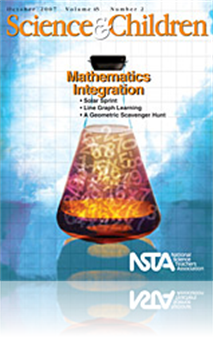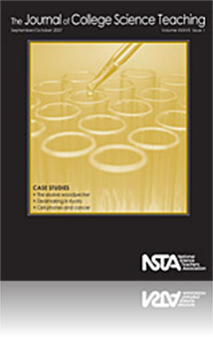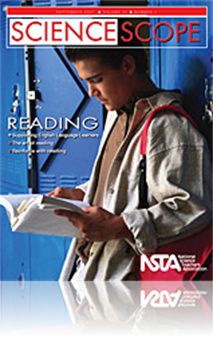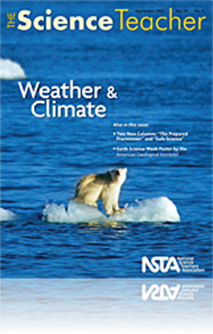All Resources
Journal Article
Modeling Leeuwenhoek’s Tools With Disposable-Camera Microscopes
When students design and build their own versions of instruments, they appreciate them more—and are more likely to appreciate how experimentation plays a critical role in explaining the world around them (NRC 1999). In this activity, students learn...
Journal Article
Idea Bank: Demonstrating the Self-Assembly of the Cell Membrane
Although the cell membrane is a complex structure, its basic form, and the self-organizing behavior of the molecules that produce it, can be easily simulated in a high school science classroom. One such simulation, described in this article, uses oil...
Journal Article
Scope on the Skies: Focus on Uranus
It wasn’t until 1781, when William Herschel aimed his six-inch reflecting telescope toward the skies, that our solar system quite literally doubled in size with his discovery of another planet—Uranus. In this month’s column, you’ll learn abou...
Journal Article
Editor’s Roundtable: Don’t know much about history? You should!
We should each examine our curriculum to make sure that we give ample time to the teaching of the history and nature of science. This issue of Science Scope contains a collection of activities and projects, both inquiry- and interdisciplinary-based...
Journal Article
Teaching Through Trade Books: Going Wild With Graphs
Just as words can tell a story, so can graphs. Pick up a newspaper or magazine and you will probably see several articles accompanied by graphs. Graphs are useful because they communicate information visually and can usually be read more quickly than...
Journal Article
Science Sampler: Weaving women into the science curriculum
Learning about great women in the sciences has the potential to impact mid-level students in a number of ways. These women and their work may serve as important role models, providing encouragement to younger female students. In addition, the stories...
Journal Article
What’s in a Word? How Word Choice Can Develop (Mis)conceptions About the Nature of Science
Despite over 10 years of reform efforts, research still shows that students typically have inadequate conceptions of what science is and what scientists do (McComas 2004; Lederman 2007). Many science students, as well as some teachers, use a single �...
Journal Article
This cooperative activity presents middle school students with the opportunity to explore and discover, as well as enjoy their own communications with one another. By employing reading, writing, and history as an integrated approach to teaching abou...
Journal Article
Methods and Strategies: Science Success for Students With Special Needs
Recent special education legislation such as the Individuals with Disabilities Act (IDEA) emphasizes the placement of students with mild disabilities in the general education classroom. Therefore, students with learning, behavior, and communicating d...
Journal Article
The Prepared Practitioner: Constructivism and Conceptual Change, Part I
Constructivism is the basis for standards, inquiry-based instruction, and a candidate for buzzword of the decade. But what is constructivism? This month’s column provides the answer to this thought-provoking question, and explains why it can be a c...
Journal Article
The Early Years: Counting a Culture of Mealworms
Math is not the only topic that will be discussed when young children are asked to care for and count “mealworms,” a type of insect larvae (just as caterpillars are the babies of butterflies, these larvae are babies of beetles). The following act...
Journal Article
Current Taxonomy in Classroom Instruction
The ability to sequence genes has vastly altered our understanding of higher-level relationships among organisms such as those found at the kingdom level. It is important for biology teachers to incorporate these new views and not retain outdated con...
Journal Article
Career of the Month: An Interview with Space Architect Constance Adams
Drawing knowledge from many fields—including science, engineering, and art—space architects such as Constance Adams design structures for nonterrestrial environments. In one such project at NASA, Adams works on elements for the International Spac...
Journal Article
Teaching Science Using Stories: The Storyline Approach
Storytelling is an age-old and powerful means of communication that can be used as an effective teaching strategy in the science classroom. This article describes the authors’ experiences implementing the Storyline Approach, an inquiry-based teachi...
Journal Article
Many children enjoy collecting items such as seashells, state quarters, and trading cards. Asking students to think about the ways in which similar items differ, how objects can be grouped by a common characteristic, and how groups can be subsets of ...
Journal Article
Tried and True: Our class periodic table
To facilitate discussions centered on the topic of chemistry, students can create a classroom periodic table. In order to accomplish this task, they research elements in the periodic table using various media (textbooks, Internet), and then create a ...
Journal Article
Launch Excitement with Water Rockets
Explosions and fires—these are what many students are waiting for in science classes. And when they do occur, students pay attention. While we can’t entertain our students with continual mayhem, we can catch their attention and cater to their des...
Journal Article
Nematodes: Model Organisms in High School Biology
In a collaborative effort between university researchers and high school science teachers, an inquiry-based laboratory module was designed using two species of insecticidal nematodes to help students apply scientific inquiry and elements of thoughtfu...
Journal Article
How Much Popcorn Will Our Classroom Hold?
How much popcorn will our classroom hold? This intriguing question sparked a terrific integrated science and math exploration that the author conducted with fifth-and sixth-grade students....
Journal Article
Extrasensory Perception—Pseudoscience?
This case teaches students to be skeptical of “scientific claims,” especially those that are sensational and fall outside the boundaries of normal scientific explanation. Students read the case scenario and then evaluate data to determine whether...
Journal Article
Science Sampler: A first energy grant—Pinwheel electrical generation
This is an interdisciplinary activity—with art, science, and math classes involved—where students design their own pinwheels, and then attach their design to a DC generator (motor). Prior to testing their designs, students are introduced to bas...
Journal Article
The Radish Party inquiry is designed to teach the importance and relevance of soil organic matter to young students. In this investigation, students grow radishes in three different kinds of soils: sand, sand plus nutrients, and potting soil (soil th...
Journal Article
Scope on Safety: Hammering home Earth-science safety
Kids love to cut up, tear apart, and smash things in order to study them. This is one reason they get so excited about the opportunity to study rocks and minerals in the lab or out in the field. Although this can certainly be fun and fuel their curio...
Journal Article
Science Sampler: Doing sophisticated science simply—Help students understand the nature of science
We all recognize the power of inquiry-based instruction when implemented in our classrooms. It engages students and motivates them to actively participate in their learning. But do our students develop a deep understanding about the nature of science...
Journal Article
Narrative informational book circles are the product of our efforts to combine current research in learning and cognition with integrated science and language-arts activities. They present instructional strategies that support students as they make c...
Journal Article
Society for College Science Teachers: Please <em> Don’t </em> Read the Text Before Coming to Lecture
It’s common for college professors to require students to complete a reading from the textbook prior to coming to class. Most professors who maintain syllabi for their courses list the chapters or page numbers that class members should read ahead o...
Journal Article
Teacher’s Toolkit: Improving science instruction through effective group interactions
Cooperative learning is a popular teaching strategy in which groups of students work together to accomplish a common goal, aiding them in developing a comprehensive understanding of a topic or concept. This strategy enables students of diverse backgr...
Journal Article
Guest Editorial: NSF Research Outreach Requirements—An Opportunity for <em> JCST </em> Readers
A recent issue of the American Physical Society newsletter (2007) described the various reactions that research physicists have to the NSF requirement that grant applications seeking support for basic research include a section describing the broader...
Journal Article
To understand more about faculty perceptions of the instructional benefits of and barriers to using case studies, the authors surveyed 101 science faculty at universities and colleges in the United States and Canada. The results provided evidence tha...
Journal Article
Fall Colors, Temperature, and Day Length
Along with the bright hues of orange, red, and yellow, the season of fall represents significant changes, such as day length and temperature. These changes provide excellent opportunities for students to use science process skills to examine how abio...









